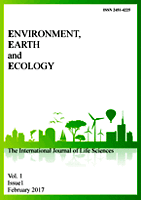| 1. |
Ahmad A, Ashfaq M, Rasul G, Wajid SA, Khaliq T, Rasul F, Naqvi SAA (2015) Impact of climate change on the rice–wheat cropping system of Pakistan. Handbook of Climate Change and Agroecosystems: The Agricultural Model Intercomparison and Improvement Project Integrated Crop and Economic Assessments, Part, 2.
|
| 2. |
Akhtar MR (2006) Impact of resource conservation technologies for sustainability of irrigated agriculture in Punjab-Pakistan. Journal of Agricultural Research (Pakistan).
|
| 3. |
Anonymous (2005) Pakistan Economic survey, Government of Pakistan. Finance Division. Economic Advisor’s wing. Islamabad. pp.11.
|
| 4. |
Aujla MS, Singh CJ, Vashist KK, Sandhu BS (1991) Evaluation of methods for irrigation of cotton in a canal irrigated area of South-West Punjab, India. Arid Soil Research and rehabilitation. 5(3).
|
| 5. |
Bakhsh KHUDA, Hassan I, Maqbool A (2005) Factors affecting cotton yield: a case study of Sargodha (Pakistan). Journal of Agriculture & Social Sciences. 1(4): 332-334.
|
| 6. |
Bhattarai SP (2005) The physiology of water use efficiency of crops subjected to subsurface drip irrigation, oxygation and salinity in a heavy clay soil. Ph.D. dissertation, Central Queensland Uni. Rockhampton, Australia.
|
| 7. |
Briddon RW, Markham PG (2000) Cotton leaf curl virus disease. Virus research. 71(1): 151-159.
|
| 8. |
Davies WJ, Zhang J, Yang J, Dodd IC (2011) Novel crop science to improve yield and resource use efficiency in water-limited agriculture. The Journal of Agricultural Science. 149: 123-131.
|
| 9. |
Ertek A, Kanber R (2001) Water use efficiency and change in the yield response factor of cotton irrigated by an irrigation drip system. Turkish J. Agri. and Forestry. 25(2): 111-118.
|
| 10. |
Goyne PJ, McIntyre GT (2001) Improving on farm irrigation water use efficiency in the Queensland cotton and grain Industries. A project of QDPI, Agency for food and fiber sciences, Farming system Institute and Australian Cotton CRC.
|
| 11. |
Hearn B (2000) The science of water balance: Why do we need to know?.In: Proceddings 10th Australian Cotton Conference, Brisbane, Queensland, Australia. pp 351-360.
|
| 12. |
Hobbs PR, Sayre K, Gupta R (2008) The role of conservation agriculture in sustainable agriculture. Philosophical Transactions of the Royal Society B: Biological Sciences. 363: 543-555.
|
| 13. |
Hood S (2002) Rural water use efficiency. Real water use efficiency and the opportunity.In: Proceedings 11th Australian Cotton Conference, Brisbane, Queensland, Australia.pp 285-295.
|
| 14. |
Howell TA (2001) Enhancing water use efficiency in irrigated agriculture. Agron. J. 93: 281-289.
|
| 15. |
Khalid HK, Rana MA, Arshad M (1999) Alternate furrow irrigation for enhancing water use efficiency in cotton. Pak. J. Agri. Sci. 36(3-4): 175-177 [Cab Absts., 1998-2000].
|
| 16. |
Khan KH, Rana MA, Arshad M (1999) Alternate furrow irrigation for enhancing water use efficiency. Pak. J. Agri. Sci. 36(3): 173-175.
|
| 17. |
Latif R, Javid AY (2014) Determinants for the Demand and Supply of Textile Exports of Pakistan (No. id: 5935).
|
| 18. |
Li-Song T, Li Y, Zang J (2005) Physiological and yield responses of cotton under partial root zone irrigation. Field Crops Research. 94: 214-223.
|
| 19. |
Makhdum MT, Chaudhry FI, Ahmad F (2001) Management of salt effected soils for sustainable cotton production. The Pak. Cotton growers. 5(2): 8-9.
|
| 20. |
McAlavy TW (2004) Researchers Investigate cotton irrigation strategies. Agricultural Communications Taxas, A & M University System, 2112 TAMUS.
|
| 21. |
Muhammad I, Nadeem K, Akmal A (2013) Value chain analysis of ginning and spinning sector of textile industry of Pakistan. In: Proceeding ASBBS. 20(1),p 789.
|
| 22. |
Noman M, Batool SA, Chaudhry MN (2013) Economic and employment potential in textile waste management of Faisalabad. Waste Management & Research. 31(5):485-493.
|
| 23. |
Raheem A, Hassan MY, Shakoor R (2016) Bioenergy from anaerobic digestion in Pakistan: Potential, development and prospects. Renewable and Sustainable Energy Reviews. 59: 264-275.
|
| 24. |
Saeed MA, Irshad A, Sattar H, Andrews GE, Phylaktou HN, Gibbs BM (2015) Agricultural Waste Biomass Energy Potential In Pakistan. In: Proceedings of the International Conference held in Shanghai, PR China. Leeds.
|
| 25. |
Sagare BN, Bhongle AT (1993) Soil moisture storage and productivity of cotton as influenced by broad base furrows. Agropedology. 3: 117-120.
|
| 26. |
Staggenborg SA, Krieg DR, Harris JL (1992) Water, nitrogen and radiation use efficiency of cotton production systems. In: Proceedings Belt wide Cotton, conference 3, p 1029-1030.
|
| 27. |
Steel RGD, Torrie JH, Dickey DA (1997) Principles and procedures of statistics. McGraw Hill Book Co., Inc. New York.
|
| 28. |
Viets FG Jr. (1962) Fertilizers and the efficient use of water. Adv. Agron. 14: 223-264.
|
| 29. |
Wiese AF, Harman WL, Regier C (1994) Economic evaluation of conservation tillage systems for dry level and irrigated cotton (Gossypium hirsutum) in the Southern great plains. Weed Science. 42(2): 316-321.
|
| 30. |
Xi-ping Deng, Shan L, Zhang H, Turner NC (2004) Improving Agricultural water use efficiency in arid and semiarid areas of China. “New directions for a diverse planet”.In: Proceedings of 4th International Crop Science Conference, Brisbane, Australia.
|







